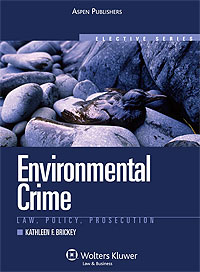Kathleen F. Brickey, J.D., the James Carr Professor of Criminal Jurisprudence
Environmental Crime: Law, Policy, Prosecution
Aspen Publishers (2008)

“Environmental Crime: Law, Policy, Prosecution” offers a unique perspective on the intersection of environmental law and criminal law. It is the first law school text devoted exclusively to the study of environmental crime.
“The advent of modern environmental legislation in the 1970s and ’80s ushered in an era of increased public and congressional support for sending polluters to jail,” said author Kathleen F. Brickey, J.D., the James Carr Professor of Criminal Jurisprudence.
“When my casebook publisher approached me about writing an environmental crime book, I viewed it as a unique opportunity to build on my previous work on environmental criminal enforcement and integrate it with my more extensive writing on traditional white-collar crime issues,” she said.
“The project also provided a welcome occasion to write for a broader audience, including non-law students who are interested in environmental studies,” she said.
Brickey uses an interdisciplinary approach to bridge the historical divide between the environmental and criminal law fields.
The book’s overview of the federal regulatory framework introduces key points at the core of the criminal enforcement debate: Did Congress overlook dangers inherent in elevating violations of existing environmental standards — originally set at levels designed for civil enforcement — into serious crimes? Are the goals of environmental law and criminal law compatible under the current regulatory regime?
These are among several recurring themes that run throughout the book. Although its primary substantive focus is on liability for violating federal laws regulating air and water pollution, hazardous waste and hazardous and toxic substances, the book also explores liability under conventional criminal statutes that prosecutors often use in tandem with environmental crime charges.
The book concludes with a close look at the criminal enforcement program: What case selection criteria do the EPA and Justice Department use to determine which environmental violations should be treated as crimes? Are environmental prosecutors “loose cannons” as some critics suggest? Or does the current system of centralized decision-making and multilevel review provide an effective check on prosecutorial discretion?
Brickey’s book is praised for its accessibility to students regardless of their technical or legal backgrounds.